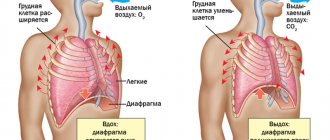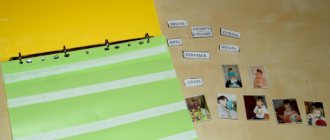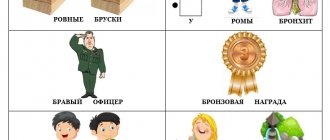Development of coherent speech in ontogenesis
In speech therapy, the term ontogenesis of speech is usually used to designate the entire period of human speech formation, from his first speech acts to that perfect state in which the native language becomes a full-fledged instrument of communication and thinking.
A.P. Luria traces the ontogenesis of speech utterances in a child. He said that the formation of a speech utterance in a child goes through several stages, from the appearance of isolated words, and then isolated independent phrases, to the most complex detailed utterance.
V.K. Vorobyova traces the genetic development of coherent speech, which is formed on the basis of situational communication and gradually moves from dialogue to forms of monologue speech: narration, and then to description and reasoning.
Dialogue as a form of speech consists of replicas, a chain of speech reactions, it is carried out either in the form of alternating questions and answers, or in the form of a conversation (conversation) of two or more participants. The dialogue is based on the commonality of perception of the interlocutors, the commonality of the situation, and knowledge of what is being discussed.
Monologue speech is understood as the coherent speech of one person, the communicative purpose of which is to communicate some facts of reality. Monologue is the most complex form of speech, serving for the purposeful transmission of information. The main properties of monologue speech include: the one-sided nature of the statement, arbitrariness, conditionality of the content by focusing on the listener, limited use of non-verbal means of transmitting information, arbitrariness, comprehensiveness, and logical sequence of presentation.
The process of formation of speech activity (and, accordingly, the assimilation of the native language system) in ontogenesis in the concept of “speech ontogenesis” by A. A. Leontyev is divided into a number of successive periods or “stages”.
1st - preparatory (from birth to one year); 2nd - pre-preschool (from one to 3 years); 3rd - preschool (from 3 to 7 years); 4th - school (from 7 to 17 years old).
So, the first stage is preparatory (from the moment the child is born to one year). In the preparatory period of speech development, in the first year of life, in the process of direct emotional communication with an adult, the foundations of future coherent speech are laid [4].
In all normally developing children, there is a certain sequence in the acquisition of the sound form of language and in the development of pre-speech reactions and is associated with screaming, humming, and babbling.
A cry is a child's first vocal reaction. Both the cry and the crying of a child activate the activity of the articulatory, vocal, and respiratory parts of the speech apparatus.
The period of walking is observed in all children. Already at 1.5 months, and then at 2-3 months, the child exhibits vocal reactions in the reproduction of sounds such as a-a-bm-bm, blb, u-gu, boo, etc. It is these that later become the basis for the development of articulate speech. Humming (according to its phonetic characteristics) is the same among all children of the world. With normal child development, babbling gradually turns into babbling at 6–7 months. The facts of the child’s first verbal manifestations, both in normal conditions and in pathological conditions, show that the babbling child initially “selects” from the adult’s speech addressed to him those words that are accessible to his articulation. Those sound manifestations of the babbling child that coincide in sound pronunciation with the words adult, are fixed. Repeated many times by an adult, they thereby become physiologically strong and frequently repeated verbal stimuli for the child. The diverse sound-articulatory manifestations of a babbling child, which have no analogues in the surrounding speech material, fade and disappear. The first speech reactions are associated with a certain range of situations or objects and are assigned to them. At 8.5–9 months, babbling already has a modulated character with a variety of intonations. But this process is not unambiguous for all children: with a decrease in auditory function, the humming “fades out”, and this is often a diagnostic symptom.
The significance of this period (noise, humming, babbling) is that in the process of pronouncing sounds, auditory perception and articulatory apparatus are improved. This leads to the possibility of imitating the sounds of the language that the child hears in the speech of others. The assimilation of the sound side of a language begins from the moment when the language begins to serve as a means of communication. This is the understanding of the words of adults addressed to the child, and the first independently pronounced words.
Based on understanding, which is very primitive at first, children’s active speech begins to develop. The child imitates the sounds and sound combinations that the adult pronounces, himself attracting the adult’s attention to himself, to some object. All this is of exceptional importance for the development of speech communication in children: the intentionality of the vocal reaction is born, its focus on another person, speech hearing and arbitrariness of pronunciation are formed (L. S. Rubinshtein, F. A. Sokhin).
The second stage is pre-preschool (from one year to 3 years). With the appearance of the child’s first words, the preparatory stage ends and the stage of development of active speech begins. Towards the end of the first - beginning of the second year of life, the first meaningful words appear, but they mainly express the desires and needs of the child. Only in the second half of the second year of life do words begin to serve as designations for objects for the baby. From this moment on, the child begins to use words to address an adult and acquires the ability, through speech, to enter into conscious communication with an adult. For him, a word has the meaning of a whole sentence. Gradually, the first sentences appear, first from two, and by two years from three and four words.
In the third year of life, both speech understanding and active speech develop rapidly, vocabulary increases sharply, and sentence structure becomes more complex. Children use the simplest, most natural and original form of speech - dialogical, which is initially closely related to the child’s practical activities and is used to establish cooperation within joint objective activities. It consists of a direct address to the interlocutor, containing an expression of request and help, and answers to the adult’s questions. Such grammatically poorly formed speech of a small child is situational. Its semantic content is understandable only in connection with the situation[4]. During this period, a separate “substage of “physiological agrammatism” can be distinguished, when the child uses sentences in communication without the appropriate grammatical design of their constituent words and phrases.
The transition from situational speech to contextual, according to D.B. Elkonin, occurs by 4-5 years. The transition to contextual speech is closely connected with the development of the vocabulary and grammatical structure of the native language, with the development of the ability to arbitrarily use language means. As the grammatical structure of speech becomes more complex, statements become more detailed and coherent.
The third stage is preschool (from 3 to 7 years). The preschool stage of “speech ontogenesis” is characterized by the most intensive speech development of children. There is often a qualitative leap in the expansion of vocabulary. Over the period from 3 to 7 years, the child increasingly develops the skill of auditory control over his own pronunciation, the ability to correct it in some possible cases. In other words, phonemic perception is formed. The main feature of this age is the emergence of the planning function of speech. In the role-playing game that guides the activities of preschoolers, new types of speech also arise: speech instructing the participants in the game, speech-message telling an adult about impressions received outside of contact with him. Speech of both types takes the form of a monologue.
Children 4-5 years old actively engage in conversation, can participate in a group conversation, retell fairy tales and short stories, and independently tell stories using toys and pictures. They do not have the ability to correctly formulate questions, supplement and correct the answers of their comrades. Their stories in most cases copy the example of an adult and contain violations of logic; sentences within a story are often connected only formally (with the words yet, then).
From 5 to 6 years of age, the child begins to intensively master monologue speech, since by this time the process of phonemic development of speech is completed and children mainly acquire the morphological, grammatical and syntactic structure of their native language.
By the end of the preschool period of development of speech activity, children normally master developed phrasal speech, phonetically, lexically and grammatically correct.
In children of senior preschool age, the development of coherent speech reaches a fairly high level. The development of children's ideas and the formation of general concepts is the basis for improving mental activity - the ability to generalize, draw conclusions, express judgments and conclusions.
The fourth stage is school (from 7 to 17 years). The main feature of speech development in children at this stage compared to the previous one is its conscious assimilation. Children master sound analysis and learn grammatical rules for constructing statements. The leading role here belongs to a new type of speech—written speech.
Children of the seventh year of life gradually master the structure of a coherent plot story, identify the beginning, climax, and denouement in the story, and use direct speech. But the content of creative stories at this age is monotonous and not always logical. The development of independent practical activity of preschool children encourages the development of the intellectual practical function of speech: reasoning, explaining methods of action, making statements, thinking about a plan for upcoming activities.
Thus, speaking about the stages of formation of a child’s speech, we turn to the periodization proposed by A. N. Leontyev, which includes the preparatory, pre-school, preschool and school stages. Based on these periodizations, we can conclude that the baby’s familiarization with the world around him begins very early and is carried out through words. With the help of words, the baby receives knowledge from adults. At first, this knowledge is elementary, then more and more profound. Therefore, for normal speech development, a child from the very first days of life needs communication and a speech environment.
So, normally, a modern child of 6.5-7 years old should master the entire system of his native language: speak coherently; express your thoughts fully, easily constructing detailed complex sentences; easily retell stories and fairy tales; pronounce all sounds correctly; have a vocabulary of four to five thousand words. And as a result, by the time a child enters school, he or she masters the basic forms of speech characteristic of adults.
Shitikova Anna Yuryevna student of TSPU named after. L.N. Tolstoy, Tula region. Novomoskovsk
Basic approaches to periodization of a child’s language development
The function of language plays an important role in the mental development of a child, during which cognitive activity and conceptual thinking skills are formed. Full language communication is a necessary condition for normal social human contact, and this, in turn, expands the child’s understanding of life in his environment. A child’s mastery of language to a certain extent regulates his behavior and helps plan appropriate participation in various forms of collective activities. Therefore, pronounced deviations in the development of a child’s speech have the most negative consequences:
- The child’s mental development lags behind;
- The formation of higher cognitive activity slows down;
- There are disturbances in the emotional-volitional sphere, which leads to the formation of special personal characteristics (withdrawal, emotional instability, feelings of inferiority, indecisiveness, etc.);
- There are difficulties in learning to write and read, which reduces the child’s academic performance and often leads to repetition of classes.
Children's language is a special stage in the acquisition of language and speech, the language of children of preschool and primary school age (up to 8-9 years). Attention to the study of children's speech is due to its originality, which reveals the characteristics of the initial stages of the formation and development of language ability, when it is carried out according to special (“non-adult”) rules.
Language acquisition is a long, multi-stage process of development of language ability, during which the child, as a result of processing and organizing language experience, develops several temporary sequential language systems that correspond to the stage of his cognitive development and ensure the realization of his communicative needs. These temporary language systems together constitute some of the stages of language acquisition. In the literature there are descriptions of the stages of language ontogenesis, which are distinguished from different positions. Thus, with any periodization, the problem arises of determining the time boundaries of the stages, since these boundaries are unclear, individual variations are significant, therefore all data on age are approximate. In addition, although the connection of one or another stage with age is important, for example, for determining the boundaries of normality and pathology in the development of a child’s language, even more important is determining the sequence of stages, the order of appearance of certain features of a child’s language.
The most common is to distinguish two age stages in the ontogenesis of speech, which differ significantly in the means of communication used by the child. At the pre-speech stage (in the first year of life) these are vocal reactions (vocalizations) and gestures, and later, after the appearance of the first words and the development of grammar, these are the actual means of speech (N.I. Lepskaya, T.N. Ushakova).
Some researchers consider the first stage of language development to be preparatory and include in it not only the stage of prelinguistic reactions, but also the stage of the appearance of the first words, which differ sharply from the child’s subsequent language; in this case, the preparatory period ends at one and a half or even two years, then the stage of language formation begins (M.I. Lysina, G.L. Rosengart - Pupko).
A.N. Gvozdev identifies the stages of formation of the grammatical structure of the Russian language in a child: 1) the period of sentences consisting of amorphous root words that are always used unchanged (1.3-1.10); 2) the period of mastering the grammatical structure of a sentence, which is associated with the formation of grammatical categories and their external expression (1.10-3); 3) the period of mastering the morphological system of the Russian language, which is characterized by the assimilation of methods of declension and conjugation (3-7).







